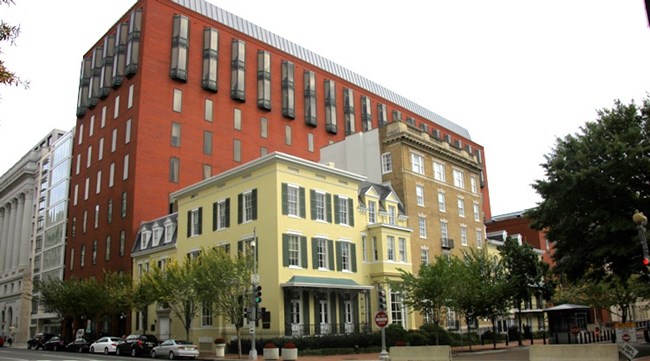Last updated: January 18, 2017
Article
The “First Neighborhood”: Presidents and Preservation in Lafayette Park

Image: Wikimedia author Tim1965
In the center of the square is the seven acre Lafayette Park, which was part of Pierre L’Enfant’s 1791 plan for Washington, D.C. Its south side faces the White House across Pennsylvania Avenue, and its other three sides are surrounded by 19th century architecture. These buildings include the homes of major historical figures such as Commodore Stephen Decatur, Dolley Madison, and Henry Adams, as well as the sites where important organizations like NASA, the National Geographic Society, and the Organization of American States were founded.
The neighborhood’s 19th century character is part of its charm today, but how this was preserved throughout the 20th century is its own story.
Presidents Franklin D. Roosevelt, Dwight D. Eisenhower, John F. Kennedy, and Lyndon B. Johnson and two First Ladies all played roles in its protection as Washington grew. In the 1930s, Roosevelt helped acquire the historic Blair House and Lee House to host presidential visitors, ensuring that these buildings wouldn’t be torn down for new office construction. In 1960, when new plans to build offices on the square reappeared, Eisenhower publicly advocated in favor of preserving the square’s historic homes.
One of the senators who had pressured Eisenhower to take this position was John F. Kennedy, who moved into the White House the next year. His wife Jacqueline Kennedy, who had studied both art history and American history, became a major force for historic preservation.
In 1961, the president and the Commission on Fine Arts (CFA) agreed on a design for a massive new modern office building that would replace several 19th century row houses bordering Lafayette Park. A local civic group called the Committee of 100 on the Federal City opposed the idea. They argued that the new office building should be located behind the 19th century row houses, and that two taller and more recent office buildings should be demolished instead. Members of the committee presented the plan to the president, published it in the newspaper, and even corresponded with Mrs. Kennedy’s mother. As First Lady, Kennedy used her prominent position to advocate for the preservation of the row houses, writing that the proposed design would be “the most unsuitable, violently modern building which would be a jarring note on the square.”
This advocacy paid off in 1962, when President Kennedy hired the architect John Carl Warnecke to design a better solution. Warnecke began with a historical study of the square, paying more attention to context than previous architects. His ultimate plan for the federal offices rose up behind and paid homage to the older row houses. This new idea was a turning point for both architecture and historic preservation. It showed that old and new buildings could complement each other instead of competing. It also demonstrated how historic preservation policy could go beyond protecting icons to preserving whole, vibrant neighborhoods.
President Lyndon B. Johnson’s administration built on this legacy. As First Lady, Lady Bird Johnson led a campaign for beautification that included historic sites as integral parts of healthy communities. She supported the passage of the first federal preservation law in 1966, the landmark National Historic Preservation Act (NHPA). When President Johnson sent the final version to Congress to consider, he attached a handwritten note that read: “Lady Bird wants it.” In celebrations of the law’s 50th anniversary in 2016, the National Park Service and other preservation groups recognized its vital role in creating a national network of historic preservation programs and partnerships. This extends from the National Register of Historic Places and the Historic Preservation Tax Incentive Program, to support for Tribal and State Historic Preservation Offices, to work with private partners such as the National Trust for Historic Preservation.
In 1970, Lafayette Square itself became a National Historic Landmark District, formally recognizing the historic character that so many presidents and first ladies had valued. The square’s preservation story ultimately reflects the national impacts of presidential advocacy. Under Roosevelt, the Historic Sites Act of 1935 showed the government’s interest in protecting important places; under Eisenhower and Kennedy, historic preservation became part of planning for growth; and under Johnson, the NHPA created a more expansive legal framework to make this possible.
Building on this framework, President Obama’s preservation legacy has focused on initiatives to tell all Americans’ stories, designating new national parks including Belmont-Paul National Historic Site to preserve the story of women’s suffrage and Stonewall National Historic Site to recognize the LGBTQ struggle for equal rights. The history of presidents and preservation is still being written.
Tags
- the white house and president's park
- whho
- white house
- lafayette park
- lafayette square
- historic preservation
- national historic preservation act
- national historic landmark district
- franklin delano roosevelt
- dwight d. eisenhower
- lyndon b. johnson
- john f. kennedy
- jacqueline kennedy
- lady bird johnson
- barack obama
- presidential history
